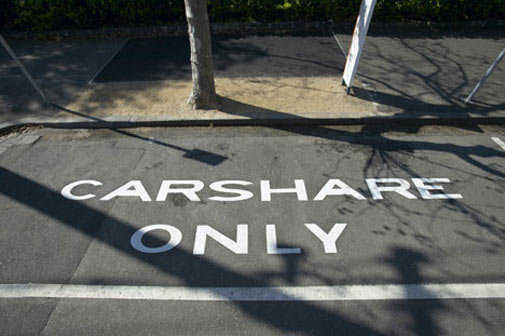In the first part of this two-part series, Berkeley, California mom Jill Suttie explored the obstacles to sharing cars in her personal life–but also the reasons why carsharing might be good for her, her family, and the planet. In Part II, Suttie looks at all the ways people can share cars.
It is indeed possible to organize a private car share with neighbors and friends, says Janelle Orsi, co-author (with Emily Doskow) of the new book The Sharing Solution.
Drawing on her experience as an attorney specializing in contractual issues around sharing, her book outlines the steps involved — and helps would-be sharers navigate potential difficulties, like scheduling issues, splitting the costs for insurance, or figuring out who pays if there is an accident.
Orsi also describes a range of private car-sharing models, from two people splitting ownership of one car to free lending of one’s car with neighbors to neighborhood cooperatives where three or more cars are shared among many — all of which keep people from owning more cars.
“There are currently 2.3 cars per household in America,” says Orsi. “But there’s a sharing revolution, too. These days it’s not about keeping up with the Joneses; it’s about sharing with the Joneses.”
Orsi’s idea is novel and appealing. But shouldn’t I still trade in the Volvo and share a more fuel efficient car with my neighbors?
According to Chris Ganson, senior research associate at the World Resources Institute, it depends. “The amount of greenhouse gases emitted in building a new car is equivalent to the amount of greenhouse gases emitted during the first year and a half of driving it,” says Ganson.
Because of this, it is sometimes less polluting to keep a car and share it with others than to trade it in.
Will Watman makes a related point on his blog Pink Salmon. “The solution isn’t getting the clunkers off the road, and forging new high mileage autos at great production expense and taxpayer cost,” he writes. “The solution has to be improving the efficiency of the capacity we have.”
In other words, having two people in a car which gets 20 miles to the gallon is as good as having one person drive a vehicle which gets 40 mpg. In fact, it’s better, because it means one less car on the road and one less car being manufactured unnecessarily.
 Like many parents, I already carpool to get my kids to and from school. But ridesharing beyond that can be a challenge.
Like many parents, I already carpool to get my kids to and from school. But ridesharing beyond that can be a challenge.
Luckily, companies like NuRide, GoLoco, and ZimRide are taking advantage of cell phone and social network technology (like Facebook) to put together people who want to share rides on a moment’s notice. To participate, you go on-line and fill in your information––letting people know what trips you are making and if you offering to drive or need a ride––and the companies match you with other ride-sharers.
According to Robin Chase, CEO of GoLoco, ridesharing has benefits besides reducing pollution, like less clogged roads, easier parking, and, of all things, more social connection. You get to know those people you ride with, at least a little. It’s a win-win proposal.
Matt Nichols, Principal Transportation Planner for Berkeley, calls dynamic ride-sharing programs like these the “Wild West” of the transportation planning world. “It’s like electronic hitchhiking, but, unlike regular hitchhiking, you don’t have to wait on the street or pick up a perfect stranger,” says Nichols.
He’s got questions about how successful dynamic ride share programs can be and how they can be expanded––“it depends on what kinds of incentives companies provide for users, like paying drivers for taking passengers or offering free parking”––but he sees programs like these as part of a healthy transportation mix.
 Beyond organized carpooling, there are carshare companies like Zipcar, UCarShare, and City Car Share, which offers cars and trucks in “pods” dotted around cities and campuses for your own personal use. These services are also using technology to make carsharing more convenient: As of last week, for example, Zipcar is offering a nifty app for iPhone and iPod Touch, which uses Google Maps to provide information about available cars.
Beyond organized carpooling, there are carshare companies like Zipcar, UCarShare, and City Car Share, which offers cars and trucks in “pods” dotted around cities and campuses for your own personal use. These services are also using technology to make carsharing more convenient: As of last week, for example, Zipcar is offering a nifty app for iPhone and iPod Touch, which uses Google Maps to provide information about available cars.
I love the idea of services like these, and I’m inspired by Orsi’s model for neighborhood car-sharing. But aren’t there down sides?
“People worry about what to do in case of emergencies,” says Orsi. “What if their kid gets sick and they don’t have a car?”
In response, some share programs offer taxi vouchers for emergencies, and private car sharers can make back up plans.
But perhaps the biggest hindrance to more widespread car-sharing is that people love their cars. “We have such a car culture; it’s hard to give that up,” says Orsi.
It’s true. I do love my Volvo and it would be hard to give it up. But, even so, car-sharing makes too much sense, environmentally and economically, to avoid it forever. It may take a little time and effort to figure out how to expand my ride-sharing or how to share my car with others; but it will pay off in cleaner air and better karma.
Plus, sharing helps build better social ties and promotes community, worthy goals in themselves. With car-sharing, who needs a Prius?









